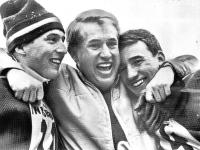When Mark Anderson answered one of my trivia questions a couple of weeks back, he also shared some interesting statistics he had discovered. “In all, the USA has won 47 Olympic alpine ski medals – only behind Austria (121), Switzerland (66), and France (48 – but we have more gold medals). Not bad.”
The United States didn’t win its first Olympic medal in alpine skiing until Gretchen Fraser brought home a Gold medal in 1948 at the 5th Winter Olympics. The U.S. women would keep us in medals with stars like Andrea Mead Lawrence, Penny Pitou, and Betsy Snite, but what about the men?
It wouldn’t be until the 1964 Winter Olympics that the U.S. men would win their first alpine skiing medals. And of course it was Stowe’s Billy Kidd winning the Silver medal and teammate Jimmy Heuga winning the Bronze.
William Winston Kidd (Billy) was born on April 13, 1943 in Burlington, Vermont. His family would move to Stowe in the early 1950s to run the Buccaneer motel on the Mountain Road. The family claims the legendary buccaneer Captain Kidd as a descendant hence the name! Billy says his father was a good skier, but was more interested in being a stylish skier while Billy just wanted to go fast. Billy began racing for the Mount Mansfield Ski Club in 1953. With influences like Marvin Moriarty who was already on the U.S. ski team, Billy had high aspirations.
Kidd’s racing ability caught the eye of Bob Beattie who was coaching the University of Colorado ski team. Billy would head for college in Colorado. In 1961 Beattie would become head coach of the U.S. Ski Team and Kidd was named to the team.
At the 1962 World Championships Kidd showed he belonged on the world stage with an 8th place finish in slalom and 15th in GS.
Injuries hampered Kidd during the 1963 season so he was a dark horse coming into the 1964 Olympics. Those Olympics were held in Innsbruck, Austria, from January 29th to February 9th. In those days there were three ski events and most competitors skied in all three! Kidd’s first event was the downhill where he would finish 16th. He says that being in the Olympics in front of 50,000 screaming Austrians got to his nerves and affected his results. In his next event which was the GS, his nerves had calmed and he finished a respectable 7th. That set the stage for the slalom where Kidd put together two strong runs and would lose to Pepi Stiegler by only .14 seconds.
Last Thursday February 8th was the 60th anniversary of that slalom! The Colorado Snowsports Museum hosted a special event to recognize that anniversary with Billy Kidd and the Heuga family in attendance. Jimmy Heuga passed away in 2010 after a long struggle with MS. In one of those remarkable coincidences, Heuga passed away on February 8th in 2010.
As an example of how skiing and particularly slalom has changed, I highly recommend going on YouTube and searching for “Billy Kidd 1964 slalom”. You’ll find videos of both runs and take a gander at those long skis! For that matter, look at those old slalom flags! Then look up any video of Mikaela Shiffrin skiing a slalom.
Back to the 1960s, Billy Kidd would compete in the 1968 Olympics with reasonable results but no medals. After winning the Gold Medal in the combined at the 1970 World Championships, Kidd retired from FIS competition. He traded his Stowe Moriarty hat for a Stetson and became the Director of Skiing at Steamboat in Colorado where he still resides and skis.
Kidd turned 80 last April 13th and good Steamboat conditions allowed him to celebrate his birthday with a ski tour that included hundreds of skiers! In his earlier days at Steamboat you could take a tour with Billy every day at 1:00. And he was the ultimate host offering technique suggestions, sharing stories from his racing days, and how to get the most out of your visit to Steamboat!
A reporter for the Steamboat Pilot asked Billy what’s the secret of skiing at 80? Billy’s response was “Be really, really good at 79 and 9/10 and then you just coast into 80!”



February 15, 2024 at 2:28 pm
I might add that like any young teen skier of the 70’s I had the Hart Comp USA ski poster of Billy on my wall – where it would stay until replaced with one of Wayne Wong. I remember how much of a presence Billy had in in the sport at that time – the Stetson really gave him a great persona.